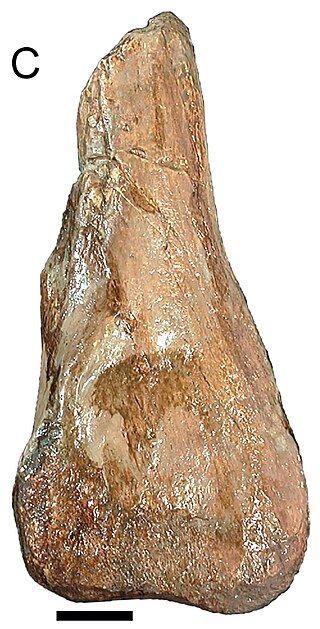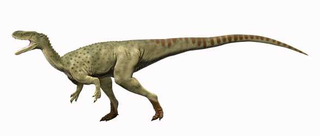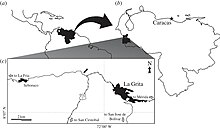Cryolophosaurus is a genus of large theropod dinosaur known from only a single species Cryolophosaurus ellioti, from the early Jurassic of Antarctica. It was one of the largest theropods of the Early Jurassic, with the subadult being estimated to have reached 6–7 metres (20–23 ft) long and weighed 350–465 kilograms (772–1,025 lb).

Torvosaurus is a genus of large megalosaurine theropod dinosaur that lived approximately 165 to 148 million years ago during the Callovian to Tithonian ages of the late Middle and Late Jurassic period in what is now Colorado, Portugal, Germany, and possibly England, Spain, Tanzania, and Uruguay. It contains two currently recognized species, Torvosaurus tanneri and Torvosaurus gurneyi, plus a third unnamed species from Germany.

Megalosauridae is a monophyletic family of carnivorous theropod dinosaurs within the group Megalosauroidea. Appearing in the Middle Jurassic, megalosaurids were among the first major radiation of large theropod dinosaurs. They were a relatively primitive group of basal tetanurans containing two main subfamilies, Megalosaurinae and Afrovenatorinae, along with the basal genus Eustreptospondylus, an unresolved taxon which differs from both subfamilies.

Liliensternus is an extinct genus of basal neotheropod dinosaur that lived approximately 210 million years ago during the latter part of the Triassic Period in what is now Germany. Liliensternus was a moderate-sized, bipedal, ground-dwelling carnivore, that could grow up to 5.15 m (16.9 ft) long. It is the best represented Triassic theropod from Europe and one of the largest known.

Ozraptor is a genus of possibly abelisauroid theropod dinosaur from the Middle Jurassic (Bajocian) Colalura Sandstone of Australia, known from fragmentary remains.

Piatnitzkysaurus is a genus of megalosauroid theropod dinosaur that lived approximately 179 to 177 million years ago during the lower part of the Jurassic Period in what is now Argentina. Piatnitzkysaurus was a moderately large, lightly built, bipedal, ground-dwelling carnivore that could grow up to 6.6 m (21.7 ft) long.
Volkheimeria is an extinct genus of sauropod dinosaurs that lived in what is now Argentina during the Early Jurassic, 178–179 million years ago. Its type and only species is Volkheimeria chubutensis.

Sarcosaurus is a genus of basal neotheropod dinosaur, roughly 3.5 metres (11 ft) long. It lived in what is now England and maybe Ireland and Scotland during the Hettangian-Sinemurian stages of the Early Jurassic, about 199-196 million years ago. Sarcosaurus is one of the earliest known Jurassic theropods, and one of only a handful of theropod genera from this time period. Along with Dracoraptor hanigani it is one of the two described neotheropods from the lowermost Jurassic of the United Kingdom.

Archaeodontosaurus is a genus of sauropod dinosaur from the Middle Jurassic. Its fossils were found in the Isalo III Formation of Madagascar. The type species, Archaeodontosaurus descouensi, was described in September 2005. The specific name honours the collector, Didier Descouens. It is a probable sauropod, with prosauropod-like teeth. It may be a basal member of Gravisauria.

Spinostropheus is a genus of carnivorous neotheropod theropod dinosaur that lived in the Middle Jurassic period and has been found in the Tiouraren Formation, Niger. The type and only species is S. gautieri.

Dracovenator is a genus of neotheropod dinosaur that lived approximately 201 to 199 million years ago during the early part of the Jurassic Period in what is now South Africa. Dracovenator was a medium-sized, moderately-built, ground-dwelling, bipedal carnivore, that could grow up to an estimated 5.5–6.5 metres (18–21 ft) in length and 250 kilograms (550 lb) in body mass. Its type specimen was based on only a partial skull that was recovered.

Ceratosauridae is an extinct family of theropod dinosaurs belonging to the infraorder Ceratosauria. The family's type genus, Ceratosaurus, was first found in Jurassic rocks from North America. Ceratosauridae is made up of the genera Ceratosaurus, found in North America, Tanzania, and Portugal, and Genyodectes, from the Early Cretaceous of Argentina. Unnamed probable ceratosaurids are known from limited material in the Middle Jurassic of Madagascar, the Late Jurassic of Switzerland, the Late Jurassic of Tanzania, and the Late Jurassic or possibly Early Cretaceous of Uruguay.
The Cerro Barcino Formation is a geological formation in South America whose strata span the Early Cretaceous to the earliest Late Cretaceous. The top age for the formation has been estimated to be Cenomanian. Earlier estimates placed the formation until the Campanian.

The La Quinta Formation is a Jurassic geologic formation which crops out in the Cordillera de Mérida and Serranía del Perijá of western Venezuela and northeastern Colombia. The formation is also present in the subsurface of the Cesar-Ranchería and Maracaibo Basins. At its type locality near La Grita, Táchira, it consists of a basal dacitic tuff followed by interlayered sandstones, tuffs, siltstones and rare limestones. Dinosaur remains including Laquintasaura, Tachiraptor, and Perijasaurus are among the fossils that have been recovered from the formation.

Averostra, or "bird snouts", is a clade that includes most theropod dinosaurs, namely Ceratosauria and Tetanurae, and represent the only group of post-Early Jurassic theropods. Both survived into the Cretaceous period. When the Cretaceous–Paleogene extinction event occurred, ceratosaurians, megaraptorans an incertae sedis group within Tetanurae, and two groups of tetanurans within the clade Coelurosauria, the Tyrannosauroidea and Maniraptoriformes, were still extant. Only one subgroup of Maniraptoriformes, Aves, survived the extinction event and persisted to the present day.

Laquintasaura is a genus of Venezuelan ornithischian dinosaur containing only the type species Laquintasaura venezuelae. The species was the first dinosaur to have been identified from Venezuela. It is known from extensive remains, all from a singular bonebed locality which has been sampled for specimen blocks over the course of several expeditions, largely led by Marcelo R Sánchez-Villagra. A small, very primitive animal, it is known for its distinct dental anatomy and for being one of the earliest and most primitive ornithischians in the fossil record. Taxonomic uncertainty has led to conflicting theories that it is either as the base of Ornithischia or at the base of the subgroup Thyreophora. In either model, its dating to around 200 million years ago, at the start of the Jurassic, existence in equatorial latitudes, and primitive nature make it a key view into early ornithischian evolution. It's thought that Laquintasaura would've lived in groups and had a possible omnivorous diet, living on a seasonal alluvial plain and being preyed about by the contemporary Tachiraptor.

Dracoraptor is a genus of coelophysoid dinosaur that lived during the Hettangian stage of the Early Jurassic Period of what is now Wales dated at 201.3 ± 0.2 million years old.
Pandoravenator is a genus of basal tetanuran theropod dinosaur from the Late Jurassic of central Patagonia. Fossils in the form of a fragmentally preserved postcranial skeleton of this dinosaur were discovered and scientifically described in 2017 by paleontologists Oliver Rauhut and Diego Pol.

Lingwulong is a genus of dicraeosaurid sauropod dinosaur from the Middle Jurassic of what is now Lingwu, Yinchuan, Ningxia, China. The type and only species is L. shenqi, known from several partial skeletons. It is the earliest-aged neosauropod ever discovered, as well as the only definite diplodocoid from east Asia.
Perijasaurus is a genus of basal eusauropod sauropod dinosaur from the "Girón-type redbeds" of the La Quinta Formation of Cesar Department, north-eastern Colombia. The type species is Perijasaurus lapaz. It lived during the Toarcian-Aalenian boundary around 175 million years ago early to middle Jurassic period.






























